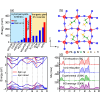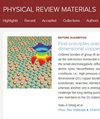Giant spin splitting and its origin in methylhydrazinium lead halide perovskites
IF 3.4
3区 材料科学
Q2 MATERIALS SCIENCE, MULTIDISCIPLINARY
引用次数: 0
Abstract
Spin splitting, or removal of spin degeneracy in the electronic energy band/level, is often a measure of spin-orbit coupling strength and a way to manipulate spin degrees of freedom. We use first-principles simulations to predict giant spin splitting in methylhydrazinium lead halide ( = Br and Cl) hybrid organic-inorganic perovskites. The values can reach up to 408.0 meV at zero Kelvin and 281.6 meV at room temperature. The origin of the effect is traced to the large distortion of framework, driven primarily by Pb ions in the ferroelectric mode. The Pb displacements consist of a combination of polar and antipolar arrangements and result in up to 39.2 meV/atom enhancement of the spin-orbit coupling energy in the polar phase of the materials. The spin-orbit coupling gives origin to persistent spin textures in , which are desirable for applications in spintronics and quantum computing. Our findings reveal an additional functionality for hybrid organic-inorganic perovskite and open a way for the design of more materials with giant spin splitting.

甲基肼卤化铅包晶石中的巨自旋分裂及其起源
自旋分裂或电子能带/电平中自旋退行性的消除通常是自旋轨道耦合强度的衡量标准,也是操纵自旋自由度的一种方法。我们利用第一原理模拟预测了甲基肼卤化铅(MHyPbX3,MHy=CH3NH2NH2,X=Br 和 Cl)有机-无机混合包晶中的巨大自旋分裂。其值在零开尔文时可达 408.0 meV,在室温时可达 281.6 meV。这种效应的起源可追溯到 PbX3 框架的巨大变形,主要由铁电 Γ3- 模式中的铅离子驱动。Pb 位移由极性和反极性排列组合而成,导致材料极性相中自旋轨道耦合能的增强高达 39.2 meV/原子。自旋轨道耦合使 MHyPbX3 产生了持久的自旋纹理,而这种纹理正是自旋电子学和量子计算应用所需要的。我们的发现揭示了有机-无机混合包晶石的额外功能,并为设计更多具有巨大自旋分裂的材料开辟了道路。
本文章由计算机程序翻译,如有差异,请以英文原文为准。
求助全文
约1分钟内获得全文
求助全文
来源期刊

Physical Review Materials
Physics and Astronomy-Physics and Astronomy (miscellaneous)
CiteScore
5.80
自引率
5.90%
发文量
611
期刊介绍:
Physical Review Materials is a new broad-scope international journal for the multidisciplinary community engaged in research on materials. It is intended to fill a gap in the family of existing Physical Review journals that publish materials research. This field has grown rapidly in recent years and is increasingly being carried out in a way that transcends conventional subject boundaries. The journal was created to provide a common publication and reference source to the expanding community of physicists, materials scientists, chemists, engineers, and researchers in related disciplines that carry out high-quality original research in materials. It will share the same commitment to the high quality expected of all APS publications.
 求助内容:
求助内容: 应助结果提醒方式:
应助结果提醒方式:


